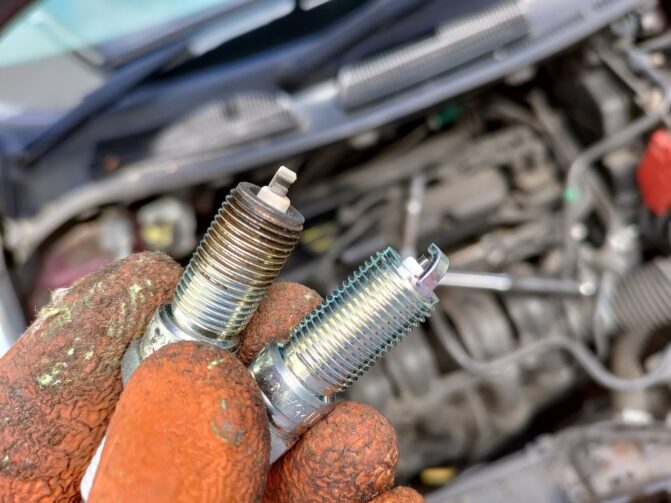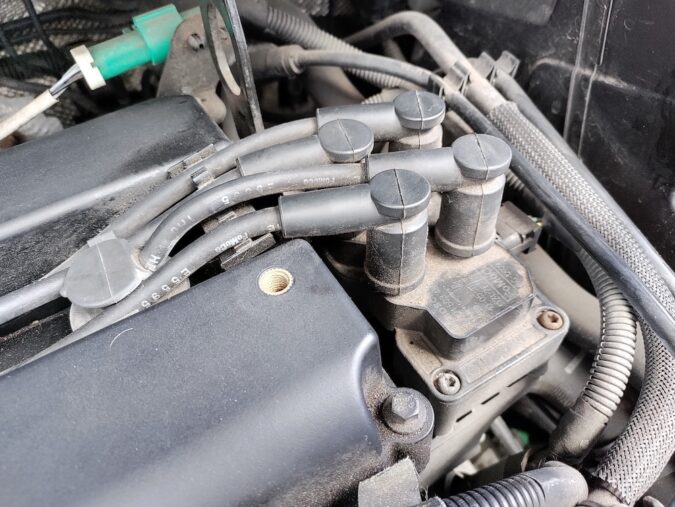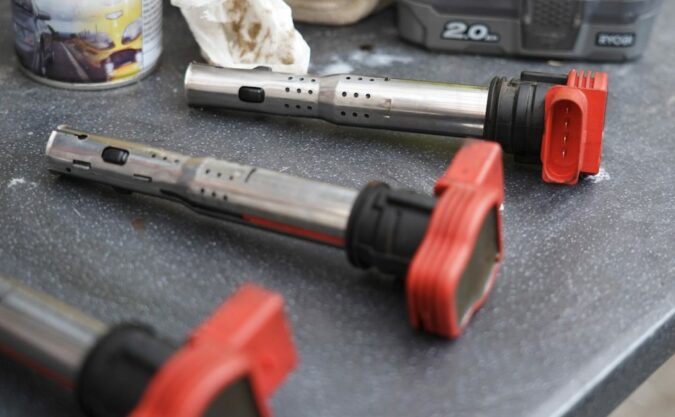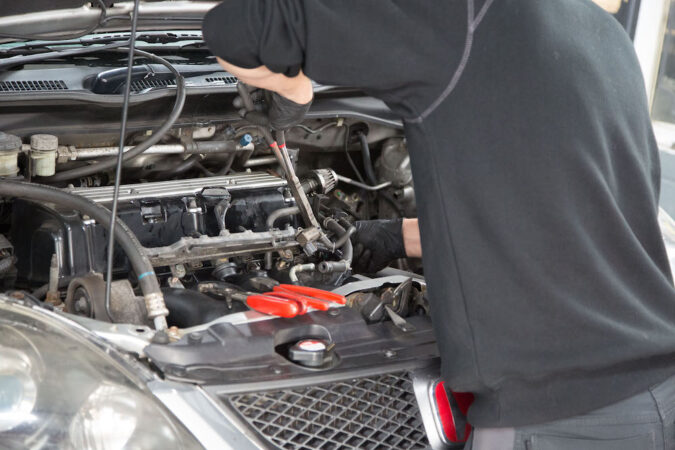P0300 Chevy is created when your engine experiences a misfire that is not limited to a single cylinder. This code is sometimes used in conjunction with others, such as P0301, which indicates a misfire on cylinder 1 (cylinder 1 being the first cylinder in the firing order).
It’s usually the engine’s front-most cylinder. If these engine codes are also present, diagnose them first because they are most likely the source of this error code. Your check engine light will illuminate as a result of this code, and it must be resolved as quickly as possible.
If it isn’t, you’ll need to replace both your catalytic converter and the issue that’s causing the misfire. A lot of circumstances can result in this OBD code. The misfire occurs on several cylinders rather than just one since it’s a “random misfire” or “multiple misfires.”
- What is Code P0300?
- What are the Causes?
- Signs and Symptoms?
- Common Mistakes
- Is it a Severe Problem?
- How to Diagnose It?
- How to Repair It?
- How much does it cost?
P0300 Code
The P0300 Chevy engine code indicates a misfiring cylinder problem in your car. The engine misfires when not enough gasoline is burnt or when the spark plug is damaged. Furthermore, in extreme conditions, it can damage your car’s catalytic converter.
“Random or Multiple Cylinder Misfire Detected” is the meaning of the P0300 error code. This diagnostic trouble code (DTC) indicates that your vehicle’s computer has identified several cylinder engine failures at irregular intervals. You’ll most likely get another OBD-II code, ranging from P0301 to P0308. Engine misfires are indicated by all of these codes.
The damaged cylinder is indicated by the final digit in the code. In the P0302 code, for example, 2 denotes the damaged cylinder. Rather than the second in the firing sequence, the cylinder number refers to the cylinder numbered “2” in the engine’s cylinder layout. Misfires can be costly to repair, thus P0300 should never be overlooked.
Cylinder Misfire
The following are the most typical reasons for engine error code P0300 Chevy:
- Ignition plugs
- Ignition coils or the distributor
- Fuel injectors
- Issues with fuel delivery
- Vacuum leaks
- Camshaft and crankshaft sensors
Misfire codes are mostly always caused by spark plugs or ignition coils. In contrast to a single P0301, P0302, or other code, P0300 Chevy is less common. Why? Plugs and coils are regular maintenance items that need to be replaced. In each cylinder, they don’t necessarily wear out at the same rate.
A single spark plug, ignition coil, or fuel injector is usually invariably the cause of single cylinder misfires. The most common causes of P0300 Chevy multiple cylinder misfire codes are still the same. Multiple misfires, on the other hand, open the door to more possibilities.
If you’re having issues with fuel distribution, it’s possible that it’s affecting multiple cylinders. Most engines have a single fuel pump that feeds all of the cylinders. As a result, a malfunctioning fuel pump, sensor, rail, or line might influence all cylinders, resulting in multiple misfires.
A cam sensor has an impact on all cylinders for which it is accountable. A crankshaft sensor has an impact on all cylinders. As a result, P0300 Chevy error codes can be caused by any of these factors.
Causes That Are Less Common
P0300 Chevy can also be caused by the following less prevalent issues:
- Ignition timing is off
- Expired fuel
- Compression is low
It’s not common to come across poor fuel quality, but it does happen. Poor fuel can cause misfires by failing to ignite correctly (usually on all or most cylinders). When the ignition timing is off, it means the timing belt or chain has snapped or jumped a few gears.
When this happens, it’s a big deal, and you’ll probably notice a lot of symptoms and driveability concerns. If this isn’t done, engines will lose compression over time (or if a failure occurs). Internal engine compression loss is a major issue. Although it’s not ideal, it’s probably the least prevalent source of diagnostic issue code P0300.
Engine Misfire Symptoms
You may notice one or more of the following symptoms if your vehicle has the P0300 Nissan problem code:
- The check engine light is illuminated. A misfire in the engine is usually indicated by a blinking check engine symbol on the dashboard. Some autos’ catalytic converters may be damaged as a result.
- A long cranking period and a rough start
- Problems with the engine’s performance, such as a lack of acceleration or hesitation
- The fuel efficiency has been drastically lowered.
- Your vehicle jerks and rattles as your engine stutters.
- Emissions test fails
Most Common Mistakes And Errors In Diagnosing
A P0300 code might be misdiagnosed in a number of different ways. Fuel injectors, oxygen sensors, and engine or drivetrain issues can all appear to be the same thing. It’s critical to understand the various sorts of engine misfire symptoms in order to diagnose the problem. You’ll be able to pinpoint the source of the issue much more quickly this way.
The most prevalent type of engine misfire symptoms is caused by defective spark plugs, ignition wires, and other electrical components. When these components fail, the engine’s spark becomes erratic, resulting in incomplete combustion.
An improper fuel-to-air ratio causes lean misfires. This indicates that there is insufficient oxygen to thoroughly burn the fuel. A defective engine computer, as well as mechanical difficulties such as a blocked air filter or a faulty fuel pump, might cause this.
Wearing mechanical components creates mechanical misfires. Piston rings, valves, and cylinder walls are prone to catch, which can disrupt your engine’s performance and place additional strain on other components. This form of failure is less common, but if left unattended, it can result in catastrophic engine damage.
A malfunctioning Engine Control Module might cause a lot of engine misfires (ECM). If this is the case, there is a simple solution, but you will also face other symptoms.
Is The P0300 Code A Severe Problem?
The P0300 error code is a serious warning that should not be overlooked. If your car’s dashboard displays this error number, it’s likely that it won’t move smoothly and that driving it could be dangerous. It’s probable that the vehicle’s engine and the catalytic converter will be severely damaged.
The P0300 code is issued when a cylinder has had repeated misfires. This code is frequently found in conjunction with other misfire codes (P0301 through P0312). When the value exceeds zero (e.g., P0306), the last number shows which cylinder is misfiring.
If an engine misfire occurs and a certain cylinder fails to fire properly, the total power output of all cylinders combined will be less than it should be. Other cylinders may have to work harder to meet the car’s power output needs, consuming more fuel. Furthermore, increasing fuel use can affect the vehicle’s gas mileage.
The P0300 error code might cause the engine’s exhaust to heat up at an alarming rate, melting the catalytic converter and making the car unsafe to drive without backpressure. Take your vehicle to an auto repair shop right away if you encounter this error code.
P0300 Chevy Code: How To Diagnose?
Always refer to the appropriate OEM literature when possible. Diagnostic processes developed by the original manufacturer should always take precedence over generic workflows.
So, let’s get started on this diagnostic procedure.
1. Preliminary Actions To Take
Clear the ECU memory and complete a driving cycle to rule out a possible intermittent DTC situation.
- Take note of the data problem codes that are displayed.
- Clear data memory error codes
- Carry out a driving test (at least 5-10 minutes).
If the Check Engine Light remains illuminated, you may have an intermittent issue. Continue with the diagnostic procedure if the light comes on throughout your driving cycle.
Compression tests on engines:
Before beginning a full diagnostic process, it’s important to examine the engine’s condition. Low compression in an engine can produce a code P0300 (along with a slew of other issues) and necessitates prompt care.
2. Visual Check
- Vacuum Hoses:
Visually inspect all vacuum lines, including the MAP sensor, PCV, brake vacuum booster, fuel pressure regulator, and other components. Also, inspect for any signs of deterioration or leaks in the air intake hose.
- MAF status:
To inspect the state of the MAF, you must first remove it from the car.
- Connectors and Wiring for Oxygen Sensors:
Visually inspect the upstream O2 sensor wiring and connectors thoroughly. Unplug the sensor and inspect it for bent terminal pins, loose connections, corrosion, or any other sign of a faulty connection.
- Inspection of the exhaust gas recirculation (EGR) system:
An unpredictable misfire condition can be caused by a leak in the exhaust or the EGR system.
- Catalytic converter evaluation:
An irregular misfire condition can be caused by a leak in the exhaust or the catalytic converter.
- Inspection of Ignition Coil(s):
Visually inspect the wiring and connectors of the ignition coil(s). Unplug each coil and inspect for bent termination pins, loose connections, corrosion, or any other probable indication of a poor connection.
- Camshaft position sensor evaluation:
Visually inspect the CMP wiring and connectors thoroughly. Unplug the CMP and inspect it for bent terminal pins, loose connections, rust, or any other probable indicator of a poor connection.
- Crankshaft position sensor examination:
Inspect the CKP wire and contacts with a magnifying lens (for the crank shaft position sensor). Unplug the CKP and look for damaged, cracked, rusted, or deteriorated wires, as well as bent terminal pins, faulty wiring, corrosion, or any other indication of a defective connection.
3. Fuel System Inspections
- Fuel Pump Pressure:
Attach a fuel pressure gauge to the engine test port with the appropriate adapter and verify the fuel pressure (engine off and engine running). Compare the figures to the OEM manuals. If the fuel pressure is not within normal limits, a lean state can develop. Low fuel pressure will result in insufficient fuel supply and, as a result, a code P0300.
- Other Tests:
Low fuel pressure might also be caused by a clogged fuel filter or highly dirty fuel injectors. Inspect the in-line fuel filter and the fuel filter element in the tank. As needed, replace them. Without an appropriate test bench, inspecting the fuel injectors is difficult.
4. Tests With The Scan Tool
- Mass Air Flow Sensor:
Using a professional scan tool for MAF diagnostics could save you a lot of time.
- Upstream Oxygen Sensor Testing:
The upstream oxygen sensor is a critical component of the emissions control system. You’ll have to double-check the wiring, connector, electrical resistance, and scan tool results.
- Ignition Coil(s) Test:
When it comes to ignition coil(s) diagnostics, using a professional scan tool can save you a lot of time.
How To Repair A P0300 Chevy Error
P0300 could be stored for a number of reasons. As a result, before performing any necessary repairs, you must accurately diagnose the code. Be well-informed, as the code might be caused by anything from worn-out spark plugs to an internal engine problem.
Also, keep in mind that each car is unique. For troubleshooting and diagnosis of incorrect engine codes, see the factory repair literature for your vehicle. Factors that can help to solve the problem
- Any damaged spark plugs, wires, or coils should be replaced.
- Clogged EGR valves or tubes should be repaired or replaced.
- Any leaks that continue to exist should be repaired.
- Head gaskets that are leaking should be replaced or repaired.
- Replace the camshaft sensor, airflow sensor, oxygen sensor, and a poor throttle position sensor that are all defective.
- Injectors and catalytic converters must be changed if they have been damaged.
- Other related error codes must be diagnosed and repaired.
- All wires, coils, and plugs, as well as the distributor cap and rotor button, need to be replaced (only if applicable to your car)
- If necessary, repair any damaged internal engine components.
- If there is cylinder damage, replace the engine.
- Replace the faulty PCM.
Repairing The P0300 Chevy Engine Code
If you want to manually solve the P0300 Chevy Silverado error code, follow these steps. Determine which cylinder(s) are misfiring and follow these instructions before initiating repairs.
1. Check The Check Engine Light Twice
The first step is to determine which cylinder is misfiring. You can do this by using an error code reader and writing down the code’s last digit. By measuring the exhaust temperature of each cylinder with an infrared thermal gun, you may also figure out which cylinder is misfiring.
2. Examine The Exhaust Temperature
Start the car while it’s still cold, then immediately take a reading in front of each exhaust port on the cylinders’ manifold while maintaining the same beam placement on each port. The cylinders that are having problems will normally be colder than the ones that are performing well. Most ports, for example, will record 190°, while the others will record 81°.
3. Remove The Wire From The Fuel Injector
If you still can’t find any clear results, start the engine and disconnect the electrical connector of each cylinder’s fuel injector (one at a time) and examine the engine’s performance. When you separate the misfiring cylinder, you’ll notice a difference in the engine’s performance.
4. Remove The Ignition Coil Connector
You may achieve the same outcome by disconnecting the coil wire connector.
5. Examine The Connectors And Wiring
Check all of the connectors and cabling that go to your cylinders if the engine lags or flinches (such as spark plugs, spark plug wires, distributor cap, and rotor). Consider replacing the component as part of your normal maintenance if it has been present for a long time. You can also take a look at the coils (and coil packs).
6. Examine The Catalytic Converter
The catalytic converter may be the source of the problem in some circumstances. If the exhaust smells like rotten eggs, it’s a sign that your converter needs to be replaced.
How To Fix Engine Misfire
When one or more cylinders fail to generate power for your car, raw fuel may enter the catalytic converter, resulting in an engine misfire. Engine misfire is a serious ailment that should be addressed right away to avoid costly repairs and a potential fire risk. The longer you ignore it, the more serious the consequences will be.
- If you’ve performed all of the following checks and determined that the spark plug is the problem, simply replacing it will cure the misfiring engine. This is the most straightforward and cost-effective option.
- You should also think about getting new spark plug wires. It will be simpler because you will be working in the same area and will need to remove the wires to change the spark plugs.
- The spark plug wires from the distributor will lead you to your ignition coil. A couple of bolts and an electrical connection must be removed before it can be removed. Depending on the age of your vehicle, you may have one or several coils.
- You may replace the intake manifold gasket yourself if you notice it is failing.
Repair Price Of P0300 Chevy
Replacing spark plugs is the most typical repair for the P0300 problem. This is also known as a tune-up, and it normally costs $150 in engines with four cylinders, rising to around $700 in engines with six or eight cylinders.
One or more of these fixes may be required to resolve error code P0300. The following is a breakdown of each repair and its associated costs:
- The cost of replacing spark plugs ranges from $40 to $640. Intake manifold removal may be required in some vehicles.
- Spark plug wire replacement costs range from $180 to $250.
- The cost of replacing ignition coils ranges from $230 to 640 dollars (Some cars may require intake manifold removal)
- The cost of replacing a fuel pump ranges from $1300 to $1700.
- Fuel injectors range in price from $1500-$1900.
- The cost of a fuel pressure regulator ranges from $200 to $400.
- The cost of repairing vacuum leaks ranges from $100 to $200.
P0300 Code: What Causes It and Ways to Fix It!
Here are 10 need-to-know facts from the article:
- The P0300 engine code indicates a misfiring cylinder problem in your vehicle, which can happen for various reasons, and you may need the help of a mechanic to figure out why the code is showing up.
- A misfire happens when the ignition timing gets wrong, and if two or more cylinders misfire, it indicates the P0300 code.
- The most common cause of the P0300 code is defective or worn-out spark plug coil packs, especially if you haven’t had a service.
- The symptoms of the P0300 code include a check engine light turning on, engine hesitation and lack of acceleration, hard starting and long cranking, and reduction in fuel economy.
- The P0300 code is serious and can have significant consequences as it can damage the catalytic converter and internal engine components.
- It is not safe to drive with a P0300 code, and you should immediately fix the misfiring to prevent further damage.
- An expert technician can diagnose a P0300 code by scanning the car with an OBD-II scanner and inspecting the spark plug coils, sensors, fuel injectors, and timing components.
- To fix a P0300 code, you must precisely diagnose the code before making any necessary fixes and consult the factory repair information for your application for troubleshooting and diagnosing faulty engine codes.
- The estimated repair costs for engine code P0300 can range from $75 to $1900, depending on the problem and your location and car type.
- A bad catalytic converter, an exhaust leak, a bad fuel pump, and a bad O2 sensor can all cause a P0300 code, and finding the right insurance for your car that provides coverage for catalytic converter replacement can save you money (bearing in mind the cost to replace catalytic converter Honda CRV).
Advice From Mechanics On The P0300 Code
Do not assume that because this trouble code indicates that a misfire, spark plugs, or ignition coils are the source of the problem. If there is a problem with a spark plug or a separate ignition coil, we normally get a trouble code for that specific cylinder.
The P0300 code indicates that there are misfires on several cylinders, which is usually caused by an air-fuel combination. If you get the P0300 code together with another P030X code. It’s more than likely an ignition problem on that particular cylinder.
If you just get a single P300 code and no P030X code, start searching for vacuum leaks around that inlet by carefully spraying starter fluid around it while the engine is running at idle to see if the RPMs rise. If the RPM rises, there’s a leak someplace that needs to be repaired as quickly as possible.
FAQs
Why Do Cars Misfire When Accelerating
When an engine misfires when accelerating or when the throttle is squeezed, it is not only harmful to the engine but also to everyone on the road. Misfires can happen when a vehicle is loaded and speeding. This causes your car to accelerate slowly or sluggishly, and it may struggle to do so. You may notice a jerking sensation when you press down on the throttle. The most common reason for an engine misfire when accelerating is worn-out spark plugs. Excessive wear on spark plugs hinders them from properly igniting the gasoline in the piston cylinder. This can be caused by faulty spark plugs, a broken distributor cap, or faulty spark plug wires. All of these problems have the same result: the coil voltage does not jump the space between the spark plugs, causing the engine to misfire as the car accelerates.
How To Avoid Getting A P0300 Chevy Code
An ounce of prevention is worth a pound of cure, as the old saying goes. Here are some preventive suggestions… Maintain a clean air filter. A blocked filter will reduce airflow, resulting in an overly rich mixture that will foul your engine. Replace your oil and fluids on a regular basis. This will prevent your gaskets from drying out, lowering the chances of a damaging leak. When the Check Engine light turns on, get your automobile serviced. It could be something insignificant, but it could also be an early warning sign that will help you avoid more serious issues down the road.
Final Verdict – P0300 Chevy
If you run a diagnostic test on your car, the P0300 code is one of the most typical codes you’ll see. One of the most serious issues with this code is that it is one of the most difficult to diagnose and repair.
In all likelihood, your car’s engine is misfiring due to a problem with the spark plugs or wires. Fuel injectors or defective sensors should not be the issue unless you have an older automobile that hasn’t been adequately maintained.




